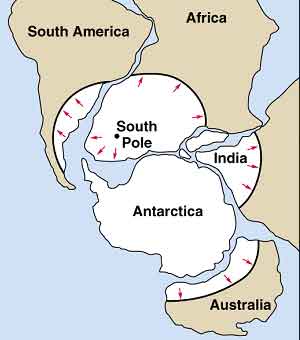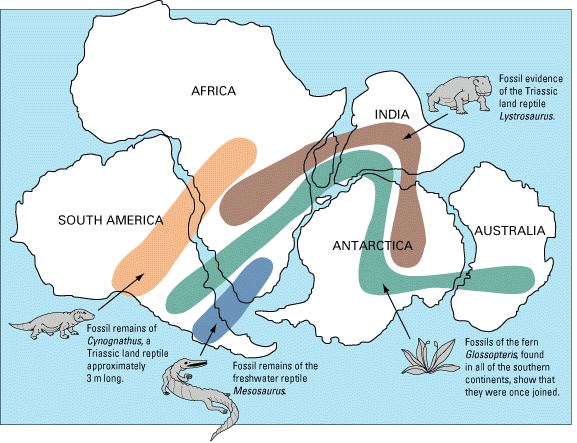Evidence of Continental
As a meteorologist Alfred Wegener was well aware of some climatological puzzles, such as the remains of temperate climate trees that can be found under polar ice. From this he began plotting world-wide distributions of both rock and fossil data that indicated tropic, desert and polar climates. From this he found that continents showed evidence of experiencing many climates.
Some of the most telling climatological evidence comes from the continents of South America, Africa, India, and Australia. All of these continents show evidence of past glaciation. This evidence comes in the form of glacial striations. Glacial Striations are left when large boulders are dragged beneath glaciers. As they drag along they scratch the underlying surface creating grooves parallel to the direction of travel of the glacier.
 |
| Map indicating glacial striations on Gondwanna continents |
Using the directions of glacial striations Wegener showed that although glacial striations in South America, South Africa, India, and Australia do indeed indicate that all experienced glaciation at about the same time, in their current positions the striation point to continental glaciers originating in different locations. However, by aligning the continents the striations point to one continental glacier originating at the pole.
As many did before him, Wegener also used the apparent puzzle-like fit of the continents as proof that continents had once been joined. However Wegener pointed out that rather than using the coastline, geologist should look at the continental slope. Unlike the shorlines the margin of the continental slope is not determined by sea level changes and is unaffected by coastal erosion; it is the true edge of the continent. By comparing the fit of continents at this edge Wegener showed and even better fit than before.
Along with new evidence gathered from his own studies, Wegener also included all previous evidence that the continents had drifted. He showed, using maps, that mountain ranges that seemed to start and end at coastlines, when the continents were aligned, matched up and formed continuos ranges with similar rock structures.
When the continental puzzle pieces were brought together, suddenly the Appalachian mountains didn't disappear into the ocean they continued into the European Caledonian Mountain range. Furthermore, the Cape Fold Belt of South Africa aligned perfectly with mountain ranges in South America.
As if this wasn't enough evidence, Wegener pointed to a tremendous amount of fossil evidence. No longer was fossil evidence limited to glossopteris. We now had evidence of identical animal species separated by thousands of miles of open water.
 |
| Map showing contiguous range of ancient species |
In particular, fossil skeletons of mesosaurus, a fresh water reptile, were discovered on the west coast of South Africa and the east coast of Southern South America. Critics of this evidence simply claimed that being a marine reptile, mesosaurus could simply swim to the other coast. However, if this were true, mesosaurus fossils should be found up and down the coasts, not limited to one specific area.
Ewing a physicist by training had worked earlier on studies of the continental shelf. His work disproved Wegner's proposal that the shelf was a permant feature that could better be used to show the fit of the continents. Instead Ewing showed that the shelf was actually made up of sediment that in some cases reached 12000 ft in depth.The fossil evidence seemed overwhelming. Besides mesosaurus, overtime hundreds of fossil would be unearthed that suggested geographic ranges of species that seemed impossible given our current geography, but regardless of all the evidence Wegener's theory would not be accepted. Like all the others before him Wegeners theory failed to provide the most crucial evidence of all: he failed to provide a plausible mechanism. In 1930 Alfred Wegner died.
